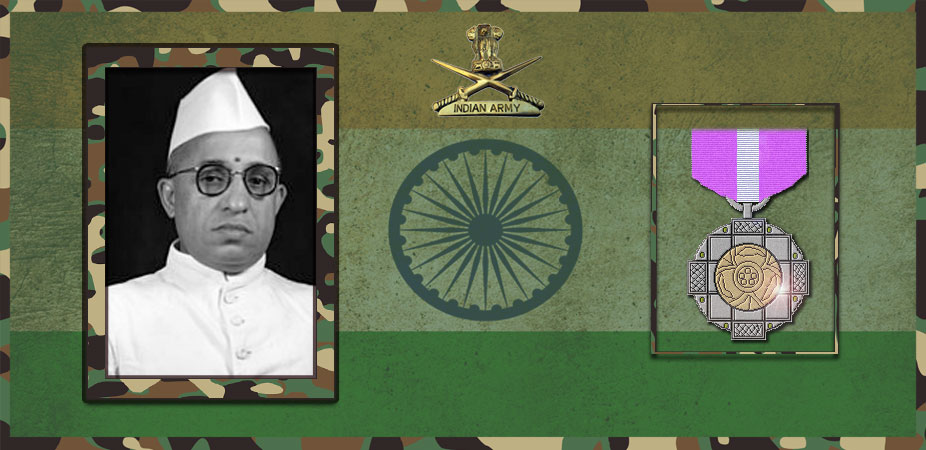Let's salute to our Indian Army together, We are proud to be Indian.
Let's salute to our Indian Army together, We are proud to be Indian.

Semmangudi Radhakrishna Srinivasa Iyer (25 July 1908 – 31 October 2003) was a Carnatic vocalist. He was the youngest recipient of the Sangeetha Kalanidhi awarded by the Music Academy in 1947 and has received many awards including Padma Bhushan and Padma Vibhushan from the Government of India, Sangeet Natak Academy award (1953), Isai Perarignar from Government of Tamil Nadu and Kalida Samman from Government of Madhya Pradesh. He was affectionately addressed as “Semmangudi Maama” (Semmangudi Uncle) by his disciples. He, along with his contemporaries G.N. Balasubramaniam and Madurai Mani Iyer, are referred to as the 20th century male trinity of Carnatic music. He was also considered the “Pitamaha” or the grand sire of modern Carnatic Music. He was conferred with an honorary doctorate by University of Kerala in 1979.
He was born in Tirukkodikaval, Tanjore district as the third son of Radhakrishna Iyer and Dharmasamvardhini Ammal. He lived with his maternal uncle Tirukkodikaval Krishna Iyer, a violin maestro, until the age of four and after his death, moved back to his parents’ home in Semmangudi, Tiruvarur District. At the age of eight he started learning music from his cousin Semmangudi Narayanaswamy Iyer. This was followed by some rigorous training under Thiruvadaimaruthur Sakharama Rao, a famous Gottuvadhyam exponent, an event considered by Semmangudi as a turning point in his life. This was followed by another training stint with Narayanaswamy Iyer, during which time he learnt a lot of varnams and keerthanams. Then he had a musical apprenticeship with Maharajapuram Viswanatha Iyer. In 1926, he performed his first music recital at Kumbakonam. In 1927 gave a concert in the Madras session of Indian National Congress, another event considered by Semmangudy as a turning point in his life, as it catapulted him into the big league of vidwans at that time. He was known for producing soulful music, highly creative and yet very orthodox, despite a recalcitrant voice.
He was instrumental, along with Harikesanallur Muthiah Bhagavathar, for the work on the krithis of Maharaja Swathi Thirunal Rama Varma.After attending one of his concerts in 1934, Maharani Sethu Parvati Bai of Travancore was so impressed by his talent and scholarship that she invited him to come to Thiruvananthapuram to edit and popularise the compositions of Swati Tirunal. He succeeded Harikesanallur Muthiah Bhagavathar as Principal of the Swathi Thirunal College of Music at Thiruvananthapuram, a post he held for 23 years, until the age of 55. At this age, he handed over his responsibilities to another Carnatic legend, G. N. Balasubramaniam and at the behest of the Government of India, became the Chief Producer of Carnatic music at All India Radio, Madras from 1957 to 1960. In later life, he concentrated on concert performances and tutoring youngsters. He gave public concerts even after the age of 90.
Semmangudi was well known for his uncharacteristically nasal voice in an era when practically every prominent Carnatic singer had an impeccable voice. In his youth, famous kanjira performer, Dhakshinamurti Pillai commented to his brother and teacher, “His voice is as melodious as the noise created when a coconut shell is scraped on a rock. Don’t bother to give him vocal training. Let him learn to play the violin.”Despite such criticism, Semmangudi worked hard to improve his voice through practice and rigorous training. In the end, his natural talent for music emerged victorious over his deficient voice and he became a phenomenon in the Carnatic world.
His singing style has been widely followed, and his prominent disciples include Sangeetha Kalanidhis, M. S. Subbulakshmi and her stepdaughter Radha Viswanathan, T. M. Thyagarajan and violinist, Prof. T. N. Krishnan. His senior disciples include Smt Parassala Ponnammal, Trivandrum G Seethalakshmi Ammal, Palai C. K. Ramachandran, Smt. Seetha Rajan, Mavelikkara Prabhakara Varma, Prof. Kumara Kerala Varma, K. J. Yesudas, P. S. Narayanaswami, V. Subramaniam, K. R. Kedaranathan, Kadayanallur Venkataraman, V. R. Krishnan, Smt. Seethalakshmi Venkatesan, Smt. Radha Namboodri, Smt. Visalakshi Ramachandran. T. M. Krishna, a leading vocalist of the present day, has also taken advanced training from him.
At a very young age, he was married to Thayyu ammal. Thayyu ammal, he always acknowledged, was a pivotal factor in the success of his career. The entire family was run with stream line precision by Thayyu ammal, when he had to frequently travel for concerts and also spend most of his time involved in music.